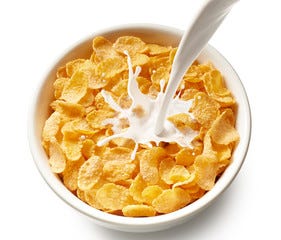Readers, I am almost positive that a bowl of cereal you ate when you were 7 years old, is different than one you had recently. When I was little, a bowl of cereal and milk would result in a soggy mess after a short few minutes. Today, with new food technology and ingredient formulations, cereal stays crunchy in milk for much longer!
Breakfast cereals, usually made of corn, wheat, oats, or rice, are processed in a manner that cooks the grain. Generally, the way they are cooked involves direct steam or continuous extrusion cooking. Baking caramelizes the sugars, which aids in the crunchy texture. The processing techniques, as well as the ingredients, coatings, additives, and packaging, all play a role in keeping cereal crunchy.
When you think of cereal flakes such as corn flakes, frosted flakes, or even raisin bran, the pieces you are seeing have been through an extruder. Milled corn or other grains are mixed in a large cooker with sugars, syrups, malts, flavors, and other ingredients to create a mixture that can then be extruded. If the cereal is to be toasted, it is poured onto a conveyor belt where it is laid to dry to a low moisture content—approximately 10-14%.
The process for puffed rice is fairly straightforward. The method used is called gun-puffing. Milled long-grain white rice or par-boiled medium-grain rice is placed in large steel vessels that are sealed tightly so that heat and pressure can build. Heat is applied to the system, and the lid flies open for a split second to allow the internal pressure to release.
In addition to extrusion, baking, and gun-puffing, other processing techniques include extruded gun-puffing, steam infusion, shredded whole grains, and rotating batch vessels.
The ingredients, such as sugar and syrups, allow for the caramelization of sugars that assist in the crunchiness of breakfast cereals, but the key to crunchy cereals truly is the grain itself. When it’s being cooked, the starch in the grain should gelatinize so that the cereal becomes rigid and porous. This structure is needed for a crunchy bite of cereal. Additionally, the gelatinization of starches reduces its water-holding ability.
A common additive is inulin, a fiber that binds pieces together. This is helpful in granola clusters and added fibers. Emulsifiers, such as lecithin, are also added to help maintain texture by preventing the separation of ingredients, ensuring a consistent crunch.
Packaging plays a crucial role as well. Modern cereals are packaged in airtight, moisture-proof materials that prevent humidity from affecting the cereal's texture. Some packaging even includes desiccants to absorb any residual moisture.
Thanks to these advances in food technology, the cereals of today offer a satisfying crunch that lasts, even when soaked in milk. Enjoy your next bowl, knowing there’s a lot of science behind every crispy bite!
Comment below what your favorite cereal brand is :)
Fast, R. B., & Caldwell, E. F. (2000). Breakfast cereals, and how they are made. American Association of Cereal Chemists.
https://www.naturalproductsinsider.com/healthy-living/keeping-the-crunch-in-breakfast-cereals




very interesting and educational - I liked reading this summary. Thank you!!!